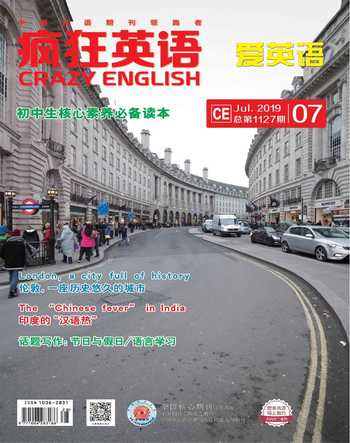话说“建议”的表达方法
张祥美
背景链接
“建议”既包括向他人提出建议,也包括接受他人的建议。如果想让对方接受你的建议,就得讲究提建议的方法。接受或拒绝他人的建议,也有一定的表达方式。
句式采集
A.提出自己的建议:
1.What / How about...? ……怎么样?
2.Why not do...? / Why dont you do...? 为什么不……呢?
3.Shall we do...? 我们做……好吗?
4.Would you mind doing...? 请你做……好吗?/ 你介意做……吗?
5.Youd better (not) do... 你最好(不)……/ 还是(不)……好。
6.Would you like...? 你想要……吗?
7.Lets do... 让我们……吧!
8.Will / Would you please do...? 请你……好吗?
9.Could you / I please...? 你/我能……吗?
10.Dont do... 不要……
11.I think you should... 我认为你应该……
12.What should I...? 我该……?
B.赞同别人的建议:
1.Good idea. / Of course. / Certainly. 好主意。/当然。
2.Yes, I think so. / Yes, please. 是的,我想是这样。/是的,请!
3.I agree with you. / With pleasure. 我同意。/我很乐意。
4.All right, Id love to. 好,我愿意。
5.No problem. 没问题。
C.不赞同别人的建议:
1.No, thanks. / No, lets...不必了,谢谢。/不必了,咱们……吧。
2.No, I dont think so. / No, Im busy. 不,我不这样认为。/不,我很忙。
3.Sorry, I wont. / Sorry, I cant. 对不起,我不会。/对不起,我不能。
4.I dont agree. / Im afraid not. 我不同意。/恐怕不行。
5.Please dont... 请不要……
◎用法点拨
1.想让对方对自己的建议提出看法时,常用“What / How about...?”,后须接名词、代词或动名词。例如:
What about going shopping? 去买东西怎么样?
2.“Why not...?”是“Why dont you...?”的省略式,用来间接地向对方提出建议,带有肯定的意味,一般不必回答,其后面跟动词原形。例如:
Why not / dont you do your homework first? 你为何不先做作业呢?
3.建议对方与自己共做某事,并希望得到肯定的答复时,用“Shall we do...?”句型委婉地提出建议。例如:
Shall we go for a walk? 咱们去散步好吗?
4.“What should I...?”有时用“Would you mind...?”替换,表示礼貌地提出建议。
【注意】mind后用动名词形式作宾语,而不用动词不定式作宾语。例如:
Would you mind my opening the door? 你介意我打開门吗?
5.“Lets...”用来当面提出建议,该句型后有时跟简短的问句“shall we?(好吗?)”, 使语气更加委婉、客气。例如:
Lets go out and have some coffee, shall we? 让我们出去喝点咖啡,好吗?
6.“Youd better...”用来提出劝告性建议,其否定式在had better后加not。例如:
Youd better not go to meet him. 你最好不要去见他。
7.“Would you like...?”表示委婉地建议某人做某事,希望对方给予肯定的回答,含有请求的意味。后接名词、代词或动词不定式。
【拓展】“Will / Would you please...?”也是一种委婉地提建议的方法,多用在口语中,would比will语气更加委婉。
8.“Could you / I please...?”句型中,情态动词could不是can的过去式,而是表示更委婉地建议,比can更加客气,答语中不可用could。例如:
—Could you please do the dishes? 你能洗碗吗?
—Sorry / No, I cant. I have a headache. 对不起/不,我不能。我头疼。
◎情景模拟
A:Hi, Tom. Its a fine day, isnt it?
B:Yes, it is. What are you going to do?
A:Nothing much. I want to go out for a picnic. Will you go with me?
B:Why not? Where shall we go?
A:Shall we go to the Great Wall?
B:Good idea. How are we going there?
A:I think wed better go there by bike. We can see much on the way.
B:I agree with you. What shall we take with us?
A:What about some food and drink?
B:All right. Lets get ready. See you later.
A:See you.
真题回放
1.—Would you like more dumplings, Harry?
— . Im full.
【2018·云南中考题】
A.Yes, please B.No way
C.No, thanks D.All right
【答案与解析】C “Yes, please.”和“No, thanks.”均为“Would you like...?” 的答语。由“Im full.”可判断,此处应该用否定回答。故選C项。
2.—Could you go swimming with me this afternoon, Jane?
— , but I have to do the chores first.
【2017·烟台中考题】
A.Id like to B.Of course not
C.I dont mind D.Its nothing
【答案与解析】A 由句意可判断,简想与问话者一起去游泳,但她首先得做家务而去不了。故选A项。

